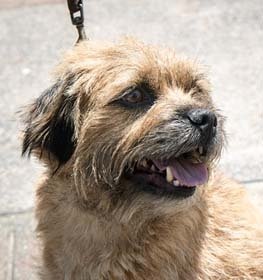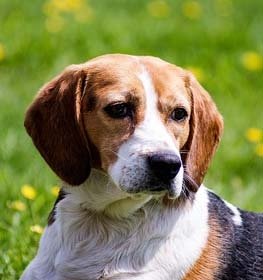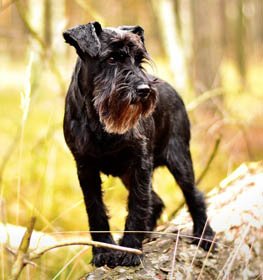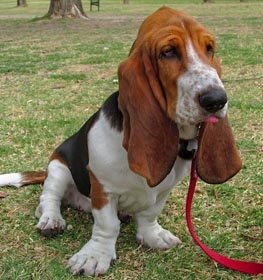Border Terrier Information & Dog Breed Facts
Collection of all the general dog breed info about Border Terrier so you can get to know the breed more.
| Group | Hunting Dogs |
|---|---|
| Popularity Rank | 92 |
| Reviews | 1 |
| User Ratings | |
|
Compare the Border Terrier With Other Dogs
Select at least one dog breed to make the comparsion. | |
 | |
| Origin | |
|
Common Names & Aliases
What other names is a Border Terrier known by? Discover all traditional, regional and informal names used for this breed. | Borders |
|---|---|
|
Breed Classification
What type of dog breed is a Border Terrier? Learn about its genetic classification and breeding category. | Purebred |
|
Size Classification
What size category is a Border Terrier? Learn how big the Border Terrier breed typically grows. | Small |
|---|---|
|
Weight Statistics
How much does a Border Terrier weigh? Discover typical weight ranges for adult males and females of the Border Terrier breed. | Males 13-16 pounds (6-7 kg), Female: 11-14 pounds (5-6 kg) |
|
Average Weight
What is the average weight of a Border Terrier? | Males 14.5 pounds (6.5 kg), Female: 12.5 pounds (5.5 kg) |
|
Height
How tall is the Border Terrier? Border Terrier height: | Male: 13-16 inches (33-41 cm), Female: 11-14 inches (28-36 cm) |
|
Average Height
What is the average height of a Border Terrier? | Male: 14.5 inches (37 cm), Female: 12.5 inches (32 cm) |
|
Price Range
How much does a Border Terrier puppy cost? Find current market prices and factors affecting Border Terrier costs. | $1200-$1400 If you choose to purchase the Border Terrier, you should know that the mentioned amount of money is an average of the collected data from breeders’ sites and puppy finder places. If you have a Border Terrier for sale, please advertise it on a reliable website to make sure the Border Terrier gets to a happy place. |
|---|---|
|
Availability
How easy is it to get a Border Terrier? How many Border Terrier are there in the world? | Very frequent: The Border Terrier is quite easy to get. There is a risk of overbreeding, as it is an extremely popular breed. Inbreeding is common because of its popularity. A new study suggests that inbreeding contributes to the incidence of disease and health problems. So be careful, buy from a trustworthy place or kennel and seek the help of an experienced person, a professional, to make the right decision. |
|
Intelligence Rating
How intelligent is a Border Terrier? Discover the Border Terrier's intelligence ranking and learning capabilities. | Smart: The Border Terrier dogs have great intelligence. They understand and memorize new commands in 15-25 repetitions.
The Border Terrier is among the smartest dogs in the intelligence ranking. |
|---|---|
|
Training Difficulty
How easy is it to train a Border Terrier? Learn about the Border Terrier's trainability and response to training methods. | Border Terrier dogs are easy to train. They find out the association between commands and actions quite quickly. |
|
Watchdog Rating
How good is a Border Terrier as a watchdog? Learn about the Border Terrier's alertness and guarding instincts. | Border Terrier dogs are good watchdogs. Their main job is to observe and they're consistent in their effort. Good vocal cords and a sense of hearing belong to them. Usually, they're territorial and protective about their property, so the Border Terrier dogs will alert you if they sense something different.
|
|
Territorial Protection
Is a Border Terrier protective of its territory? Learn about the Border Terrier's guarding instincts and behavior. | Border Terrier dogs are extremely protective guard dogs. This breed doesn't hesitate to protect its territory so the Border Terrier can be a good choice if you want an excellent guard dog. Keep calm and the Border Terrier will take care of unwanted people or animals. |
|
Personality Traits
What personality does a Border Terrier have? Learn about characteristic Border Terrier temperament and behavior traits. | AlertIntelligentAffectionateObedientOutrightTemperedFearless |
|---|---|
|
Sensitivity Level
How sensitive are they? Border Terrier sensitivity: | Border Terrier dogs have an average emotional level and are not the most sensitive dog breed. Sometimes it's okay to change the daily routine, have guests and listen to loud music.
Some dogs handle moderate punishment very well, while others crumble apart at a dirty look. This breed is not affected emotionally by moderate punishment. |
|
Affection Level
How affectionate are they? Is a Border Terrier a good family dog? | High: Border Terrier dogs are genuinely loyal, soft and gentle, loving, and affectionate dogs toward their handlers. They enjoy quality time with their owners despite the activity and are considered great therapy dogs for those in need. This breed responds strongly to their handler's emotions because they bond closely. Their happiness is your happiness. |
|
Social Needs
How much social interaction does the Borders need? Border Terrier social needs: | Border Terrier dogs need for social interaction is average. This breed likes being around people or other animals, but they don't mind being left alone for a few hours either. |
|
Impulse to Wander or Roam
How likely is the Border Terrier to run away? Does this breed explore or wander a lot? Does Border Terrier roam? | The wanderlust potential of the Border Terrier is strong enough to escape from home. They have a strong desire for exploring the world. Safer to walk them on a leash unless you teach them how to get back to you on command. |
|
Prey Drive
Do this canine have a strong prey drive? Does Border Terrier have high prey drive? | Border Terrier dogs have a high impulse to chase and catch something. Cats or any other small animals are in danger. It's a natural instinct, doesn't necessarily mean that Border Terrier dogs are aggressive. Better to keep this breed on a leash. |
|
Barking Frequency
Does a Border Terrier bark a lot? Learn about typical Border Terrier vocalization patterns and triggers. | Average to High: The Border Terrier is a vocal breed. Not the best choice if you prefer a quiet breed. They often bark loudly and howl sometimes. They can change their barks depending on their emotional level and what they're trying to say. Different barks could mean the same and the same barks could have different meanings.
Top reasons for barking: protection, alarm, fear, boredom, attention-seeking, greeting, separation anxiety, compulsive barking. |
|---|---|
|
Playful Nature
How playful is a Border Terrier? Understand the typical play drive and energy level of the Border Terrier breed. | Average: Border Terriers, like any other dog breed, like playing. Sometimes they bark in excitement for playing, but they are not the most playful dog breed. |
|
Apartment Adaptability
Can a Border Terrier live in an apartment? Learn about the Border Terrier's suitability for apartment living. | Very house-friendly dog the Border Terrier breed. It's good if you have a small garden where he can go out and do his business, but it's not important at all. You can get enough exercise with one or two walks a day, so keeping them indoors shouldn't be a problem. |
|
Lifestyle Adaptability
How adaptable is a Border Terrier to lifestyle changes? Learn about the Border Terrier's flexibility to new situations. | Border Terrier dogs adapt very well to lifestyle changes and basically all living environments. They don't mind moving from one place to another with their owner. |
|---|---|
|
Alone Time Tolerance
Can a Border Terrier be left alone? Learn about the Border Terrier's tolerance to solitude. | Just like every puppy, they are prone to panic, cry, bark, whine when they left alone by their owner. With proper socialization and quality time with the dog can solve this problem. |
|
Bite Risk Assessment
What is a Border Terrier biting potential? Learn about the Border Terrier's bite risk factors. | Low 🔽 The Border Terrier has a low chance of biting somebody. Top reasons for dog bite: protection, pain, excitement, herding instinct, being provoked. (Data based on the available online bite statistics.) |
|---|---|
|
Mouthing Tendency
Is a Border Terrier mouthy? Learn about the Border Terrier's tendency to use mouth during play. | Border Terrier dogs have a strong tendency to nip, chew, play-bite, or herd people. It's a common habit during puppyhood, not aggressive behavior. These "bites" don't hurt, but Border Terrier dogs need to be taught a good attitude.
We have compiled a list of Mouthy Dog Breeds. |
|
Bite Strength Rating
How strong is a Border Terrier bite? Learn about the Border Terrier's bite force measured in PSI. | Between 100 and 200 PSI 🔽 Border Terrier bite force: Weak. The Border Terrier bite force is considered weak when compared to other dog breeds. The bite force Border Terrier measurements usually fall below 200 PSI, making them one of the breeds with the weakest bite force. The bite force of a Border Terrier may be weak, but it's important to remember that any dog's bite can still be dangerous if not managed properly. Despite the bite force of Border Terrier being lower, it does not make them any less lovable or enjoyable as pets.
Border Terrier bite wounds might not be as severe, but it is still essential to be cautious and prevent any biting incidents. They are usually not aggressive and very friendly towards children and other animals. To ensure a well-behaved dog, it's essential to learn how to train a Border Terrier puppy not to bite from an early age. With proper training and socialization, a Border Terrier can be a wonderful addition to any family, providing love and companionship for years to come. |
|
Average Lifespan
How long does a Border Terrier live? Learn about the typical lifespan of the Border Terrier breed. | 11-15 years The average lifespan of Border Terrier: 13 years |
|---|---|
|
Climate Tolerance
How well does a Border Terrier handle different weather? Learn about the Border Terrier's climate adaptability. | Prefers average to cold weather conditions The Border Terrier can adapt to well to cold weather conditions, some dogs even can be a good mountain dog. |
|
Health Concerns
What health issues are common in a Border Terrier? Discover typical conditions affecting the Border Terrier breed. | The Border Terrier is a healthy breed, but there are certain health issues that you should check with your vet regularly. |
|
Vet Care Frequency
How often does a Border Terrier need vet visits? Learn about the Border Terrier's veterinary care requirements. | Average The Border Terrier should have a complete physical check-up at least once per year. If your dog shows any symptoms, call your veterinarian. |
|
Health Problems
What genetic/health problems does the Border Terrier breed have? What are the health issues and concerns of the Border Terrier breed? Most common health risks of Border Terrier: | Heart Murmurs Hip Dysplasia Patellar LuxationHypothyroidismCryptorchidismSeizuresMalocclusionsPulmonic Stenosis |
|
Energy Rating
How energetic is a Border Terrier? Understand daily activity needs of the Border Terrier breed. | Border Terrier dogs have a higher energy level than other dog breeds. If you want a dog for snuggling on the couch, this breed isn't the perfect choice for you. |
|---|---|
|
Activity Requirement / Exercise Need
How much exercise does a Border Terrier need? How much exercise do Border Terrier dogs require per day?
Do Border Terrier dogs need a lot of exercises? | Border Terrier dogs have an average exercise need. This breed is satisfied with short walks every weekday and a long ones on weekends. |
|
Sleeping Need
How much sleep does the Border Terrier breed need? | Border Terrier dogs are quite energetic dogs and they don't spend too much time with sleeping. If you live an active life, this breed can be a good choice for you. |
|
Obesity Tendency
Is a Border Terrier prone to weight gain? Learn about the Border Terrier's obesity risks. | High: The Border Terrier breed has a strong tendency to be overweight. Try to find the happy medium between exercise and feeding. If you want to keep balance, increase the amount and frequency of your daily dog walk and play with the Border Terrier more often.
If you notice any weight gain, consult your veterinarian and make a diet plan. Reduce unhealthy food and snacks, and measure the Border Terrier weight regularly. |
|---|---|
|
Food Consumption
How much food does a Border Terrier need daily? Learn about the Border Terrier's feeding requirements. | 1 to 1.5 cups of high-quality dry food a day, divided into two meals. |
|
Allergy Friendliness
Is a Border Terrier hypoallergenic? Learn about the Border Terrier's suitability for allergy sufferers. | Yes Border Terrier dogs do well with allergy sufferers by causing fewer allergic reaction. However there are no 100% hypoallergenic dogs in the world, there are a variety of breeds that are considered to reduce or minimize the possibility of an allergic response. Coat type isn't necessarily relevant, because most people are allergic to dander (flakes on the dog's skin) or saliva, not actually to dog hair. |
|---|---|
|
Coat Colors
What colors does a Border Terrier come in? Discover all possible Border Terrier color variations. | Tan Red Blue Grizzle Wheaten |
|
Grooming Requirements
How much grooming does a Border Terrier need? Learn about Border Terrier coat maintenance requirements. | Average: The Border Terrier requires average grooming effort. Cutting the dog's hair by a professional groomer isn't essential. Brushing the dog's coat is useful to reduce shedding. Ears and eyes should be cleaned regularly to avoid infections. Don't skip the seasonal flea treatment too. Dog nail trimming and dog bath can be helpful sometimes. Check the local pet store for dog grooming supplies and find the best dog shampoo to keep its coat healthy and give your dog a pleasant experience of a dog bath. If you don't have the time, skill, or money to take care of your Border Terrier, search for a dog groomer or clipping service in your area and book an appointment. Maybe you're lucky to have a dog boarding service that includes grooming or walk-in dog bath places nearby. |
|
Drooling Tendency
Does a Border Terrier drool a lot? Learn about the Border Terrier's drooling habits. | The Border Terrier is a perfect example of a very low drooling tendency. If you're disgusted by slobber spots on your clothes, the Border Terrier could be a perfect choice for you. Drooling is the unintentional saliva flowing outside of the mouth. It can be completely normal or a sign of a health problem. Certain dog breeds drool minimum compared to others, just like the Border Terrier.
If you notice any change in your dog's drooling habit, you should contact a vet as soon as possible. |
|
Stinkiness Rating
Does a Border Terrier smell bad? Learn about the Border Terrier's natural odor levels. | Medium ⏺ The Border Terrier has an average chance of bad smell. Top reasons for dog stinkiness: infection of bad tooth/ear/skin folds, gas attacks. |
|
Coat Characteristics
What type of coat does a Border Terrier have? Learn about the Border Terrier's fur characteristics. | Rough |
|
Bathing Needs
How often does a Border Terrier need baths? Learn about the Border Terrier's bathing requirements. | 4-6 weeks Average. Experts recommended at least every 4-6 weeks for this family pup. According to a study, 56% of pet parents don’t bathe their dogs as frequently as they should, and 60% use the sniff test when deciding when it’s bath time.
Bathing your dog is beneficial to them in more ways than just one. It’s also a good time to look for unusual scratches, bumps, fleas, and other irregularities. When their hair is wet and flat against their body, these details are more visible. |
|
Shedding Level
How much do Border Terrier dogs shed? How to control, reduce and prevent the shedding of the Borders? Do Border Terrier dogs shed a lot? | Border Terrier dogs shed none to minimal. Having a puppy from this breed you don't have to be afraid of your couch or car being covered by dog hair. Border Terrier dogs could be the best choice if you don't tolerate dog hair. |
|
Child Compatibility
Is a Border Terrier good with children? Learn about the Border Terrier's behavior around kids of different ages. | Border Terrier dogs are very kid-friendly dogs. This breed enjoys being surrounded by children.
|
|---|---|
|
Pet Compatibility
How well does a Border Terrier get along with other pets? Discover the Border Terrier's compatibility with other animals. | Border Terrier dogs usually don’t get on well with other pets. |
|
Stranger Friendly
Are they aggressive or friendly towards/with strangers? Border Terrier temperament with other people: | Border Terrier dogs are not the most stranger-friendly dogs. |
|
Cat Friendly
How well do Border Terrier dogs get along with cats? Are they good with kittens? What is this fido's temperament with cats? Can they be good with cats? Can the Border Terrier breed live with a cat? | Border Terrier dogs are not the most cat-friendly dogs. |
|
Dog Friendly
Is Border Terrier good with other dogs? Are they dog-friendly dogs? How well do Border Terrier dogs get along with other dogs? | Border Terrier dogs are not the most dog-friendly dogs. If you want more dogs in your family or you'd like to join dog meetups, the Border Terrier is not a good choice. |
|
Good For First Time Owners
Is Border Terrier breed good for first-time owners? Do they make a good dog for novice owners? Is Border Terrier breed suitable for first-time owners? | Yes Border Terrier dogs are good for novice owners, due to their easy-going personality. |
|
Office Friendly
Are Border Terrier dogs good office canines? Do Border Terrier dogs make good office-friendly pets? Can they be office dogs? | No Border Terrier is not the best dog breed for office environment. |
|
Senior Citizens Friendly
Are they senior citizens friendly dogs? How well do Border Terrier dogs get along with the elderly people? What is the Borders temperament with senior people? Are Border Terrier dogs good for elderly owners? | Border Terriers are one of the best breeds for elderly people. |
|
Service Dog Capability
Can a Border Terrier be a service dog? Learn about the Border Terrier's service work potential. | Not really This breed generally not used as a service dog. A service dog is a term used in the USA to refer to any type of assistance dog specifically trained to help people who have disabilities, such as visual impairment, hearing impairments, mental disorders, seizures, mobility impairment, and diabetes. Service dogs are protected under the ADA (Americans with Disabilities Act).
Border Terrier is not the best breed for service purposes. |
|---|---|
|
Therapy Work Suitability
Is a Border Terrier good as a therapy dog? Learn about the Border Terrier's therapy work aptitude. | Not really This breed is generally not used as a therapy dog. A therapy dog is a dog that might be trained to provide affection, comfort, and love to people in hospitals, retirement homes, nursing homes, schools, hospices, disaster areas, and people with anxiety disorders or autism.
Border Terrier is not the best breed for therapeutic purposes. |
|
Scent Detection Ability
Is a Border Terrier good at detection work? Learn about the Border Terrier's scenting abilities. | Not really They are not typically employed for this type of work, but there may be exceptional cases. A detection dog or sniffer dog is a dog that is trained to use its senses (mostly its smell) to detect substances such as explosives, illegal drugs, wildlife scat, currency, blood, and contraband electronics such as illicit mobile phones.
Border Terrier is not the best breed for detection purposes. |
|
Search & Rescue Potential
Can a Border Terrier do search and rescue? Learn about the Border Terrier's SAR capabilities. | Not really This dog breed is not typically used as a search and rescue dog. The use of dogs in search and rescue (SAR) is a valuable component in wilderness tracking, natural disasters, mass casualty events, and locating missing people.
The Border Terrier is not the best breed for SAR purposes. |
|
Maritime Work Ability
Is a Border Terrier good on boats? Learn about the Border Terrier's maritime capabilities. | Not really Border Terrier breed usually doesn't like being on a boat. Boat dogs were typically bred for their strength, stamina, and water resistance, as they were often required to perform tasks such as pulling in fishing nets, and jumping into the water to retrieve ropes or lines, or helping to move cargo. Sailor dog is a type of dog that was bred to accompany sailors on their voyages. They were typically used for three purposes: as a working dog, a watchdog, and as a companion. A boat dog is a term used to describe a type of dog that was traditionally bred and used as a working dog on boats. |
|
Draft Work Capability
Can a Border Terrier pull carts? Learn about the Border Terrier's drafting abilities. | Not really A drafting dog or draft dog is a dog bred and used for cart pulling. Dogs bred for this work have strong builds and qualities that are needed, strength and determination.
Border Terrier is not the best breed for drafting purposes. |
|
Military Service Background
Was a Border Terrier used in military service? Learn about the Border Terrier's military history. | Not really In history, this breed was not really used for combat dog. |
|
Puppy Litter Size
How many puppies does a Border Terrier usually have? Learn about typical litter sizes. | 2-8 puppies |
|---|---|
|
Pregnancy Duration
How long is a Border Terrier pregnant? Learn about the Border Terrier's gestation period. | 60-64 days Reproductive cycle of the female Border Terrier: The first period called Proestrus lasts for about 9 days.
During this time the females start to attract males. You can notice by swelling vulva and bloody discharge. The second part is the Estrus when the female is receptive for the male. It lasts for about 3 to 11 days. The sign of the proestrus part is the soft and enlarged vulva. The discharge decreases and lightens in color. The third part is the Diestrus. Normally, it occurs around day 14. In this period the female’s discharge changes for vivid red and coming to its end. The vulva returns to average, and she will no longer permit mating. The fourth part called the Anestrus. The time frame between heat periods normally lasts about six months. |
|
Breeding Frequency
How often can a Border Terrier have puppies? Learn about safe breeding intervals. | Once a year. More frequent breeding is not healthy. It is very important not to buy a dog from a puppy mill, where the needs of the pups and their mothers are ignored. It's an inhumane high-volume dog breeding facility, where puppies born several times a year. |
|
AKC Classification
What AKC group is a Border Terrier in? Learn about the Border Terrier's AKC classification. | Not recognized by the American Kennel Club. |
|---|---|
|
FCI Classification
What FCI group is a Border Terrier in? Learn about the Border Terrier's international classification. | Recognized by FCI in the Terriers group, in the Large and medium sized Terriers section. |
|
Kennel Club Recognition
Which kennel clubs recognize a Border Terrier? Learn about the Border Terrier's official recognition. | American Canine RegistryAmerican Kennel ClubAmerica's Pet RegistryCanadian Kennel ClubDog Registry of America Inc.Federation Cynologique InternationaleKennel Club of Great BritainNorth American Purebred Registry, Inc.American Canine Association, Inc.Australian National Kennel CouncilContinental Kennel ClubNational Kennel ClubNew Zealand Kennel ClubUnited Kennel ClubBorder Terrier Club Of America, Inc.Club Espanol De Terriers |
Border Terrier Pros and Cons
- Intelligence Rating: Smart: The Border Terrier dogs have great intelligence.
- Training Difficulty: Border Terrier dogs are easy to train.
- Allergy Friendliness: Border Terrier dogs do well with allergy sufferers by causing fewer allergic reaction.
- Apartment Adaptability: Very house-friendly dog the Border Terrier breed.
- Shedding Level: Border Terrier dogs shed none to minimal.
- Drooling Tendency: The Border Terrier is a perfect example of a very low drooling tendency.
- Watchdog Rating: Border Terrier dogs are good watchdogs.
- Lifestyle Adaptability: Border Terrier dogs adapt very well to lifestyle changes and basically all living environments.
- Child Compatibility: Border Terrier dogs are very kid-friendly dogs.
- Senior Citizens Friendly: Border Terriers are one of the best breeds for elderly people.
- Good For First Time Owners: Border Terrier dogs are good for novice owners, due to their easy-going personality.
- Obesity Tendency: High: The Border Terrier breed has a strong tendency to be overweight.
- Mouthing Tendency: Border Terrier dogs have a strong tendency to nip, chew, play-bite, or herd people.
- Impulse to Wander or Roam: The wanderlust potential of the Border Terrier is strong enough to escape from home.
- Cat Friendly: Border Terrier dogs are not the most cat-friendly dogs.
- Dog Friendly: Border Terrier dogs are not the most dog-friendly dogs.
- Office Friendly: Border Terrier is not the best dog breed for office environment.
Border Terrier History
Introduction
The Border Terrier is a British breed of small, rough-coated terrier. Admirers of the upbeat and agile Border Terrier cherish their breed’s reputation as a tough, no-frills working terrier.
These friendly dogs are popular in both the city and the countryside. Their wiry coat is easy to maintain and their height ranges from 11 to 16 inches at the shoulder.
They are easy to recognize among other small terriers by their unique head shape known as an ‘otter head’.
Another distinctive feature is that their legs are longer than those of other little terriers. Moreover, Border Terriers are described as ‘hard as nails when working, but at home, they are good-tempered, affectionate, and easily trainable.
They also get along well with other dogs, but when cats or squirrels cross their way, their hunting instincts are piqued.
Origins
The Border Terrier was once known as the Coquetdale Terrier or the Redesdale Terrier from the area in which it evolved, but by the late 1800s, it had become widely recognized as the Border Terrier, probably because of its long association with the Border Hunt in Northumberland.
The breed shares its ancestry with that of the Bedlington Terrier and the Dandie Dinmont Terrier from the same area. The Border Terrier is a breed that originated during the 18th century in the rugged and at times desolate, hill territory that may be found on both sides of the English-Scottish border.
‘The Border Country’ is a nickname for this area. Farmers and shepherds in the area established the breed after using terriers to help control the local fox population.
Foxes were and still are in The Border Country, a predatory animal of particular concern to sheep farmers whose flocks wander relatively free over many thousands of hectares of heath and heather-covered land.
In the 19th century, when foxhunting developed into the sport we know today, the breed began to be used as part of the more formal foxhunting scene.
Border Terriers were built to have a long, narrow, flexible body, the better to squeeze through narrow holes and flush foxes out of their hiding places, and they have legs long enough to follow the horses during a foxhunt.
Of course, they had the stamina to spare, a weather-resistant coat, and thick, loose skin that wasn’t easily pierced by the teeth of their foxy adversaries.
However, the Border Terrier should not be too forward in attacking the fox underground, rather he should threaten them and preferably chase them out. The breed should also be able to go to the ground and follow a fox into any space in which it could go.
Recognition
Furthermore, while the breed was prized in England’s border country for its fearless and implacable nature, the Border Terrier was little known outside of its home.
Many people have seen the breed at agricultural shows in Northumberland in the late 19th century, but dog fanciers took little notice of him until the early 20th century.
In 1920, he was recognized by England’s United Kennel Club, and a breed club was also formed. Moreover, in 1930, Netherbyers Ricky became the first Border Terrier to be registered in the United States when he was accepted by the American Kennel Club.
For most of his existence, the Border Terrier has been unknown and his people prefer that he stay that way if it means protecting him from the ravages of popularity. Among the 155 breeds and varieties listed within the American Kennel Club, the Border Terrier currently ranks 81st.
Latest Border Terrier Compares
Border Terrier Names
How old is my Border Terrier in human years?
You May Also Like
Rate The Border Terrier Breed
Border Terrier Comments, Reviews and Questions
- idk man
Oct 21, 2023, 10:21:18 PM:




